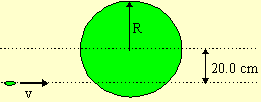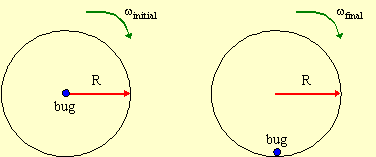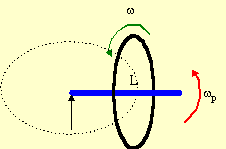![[Return to Physics Homepage]](./../../physics.gif)
![[Return to Mike Coombes' Homepage]](./../../coombes.gif)
![[Return to List of Handouts]](./../../handouts.gif)
![[Return to Problem Sets]](./../../problems.gif)
![[Return to List of Solutions]](./../../solutions.gif)
Questions: 1 2 3 4 5 6 7 8 9 10
Angular momentum is defined as the cross product
of position and momentum, L = r ×
p. The direction of the angular momentum is perpendicular
to the plane formed by the position and momentum vectors. For this
problem that means either into the paper, denoted by
×, or out of the paper, (·).
To find the direction, we sweep our right hand
through the smallest angle formed by the vector. The way the
thumb points indicates the direction of the angular momentum.

The angular momentum can be found either by evaluating
the determinant or by using L = rpsinφ.
We will use the first method to find L. We can find
the angle between the momentum and position vectors using
φ = sin-1(L/rp). We find
the magnitudeof the vectors using the 3D form of the
Pythagorean Theorem.
(a)

L = [(-2)2 + (11)2 + (21)2]½
= 23.791 kg-m2/s
r = [(4)2 + (-5)2 + (3)2]½
= 7.0711 m
p = [(1)2 + (4)2 + (-2)2]½
= 4.5826 kg-m/s
φ = sin-1(L/rp) = sin-1[ 23.791 / (7.0711 × 4.5826)] = 47.2°
(b)

L = [(1)2 + (20)2 + (13)2]½
= 23.875 kg-m2/s
r = [(1)2 + (-2)2 + (3)2]½
= 3.7417 m
p = [(7)2 + (-1)2 + (1)2]½
= 7.1414 kg-m/s
φ = sin-1(L/rp) = sin-1[ 23.875
/ (3.7417 × 7.1414)] = 63.3°
(c)

L = [(0)2 + (0)2 + (-2)2]½
= 2 kg-m2/s
r = [(0)2 + (2)2 + (0)2]½
= 2 m
p = [(1)2 + (0)2 + (0)2]½
= 1 kg-m/s
φ = sin-1(L/rp) = sin-1[ 2
/ (2 × 1)] = 90°
The angular momentum of a rotating body is L = IΩ.
An LP is a solid disk. Consulting a table of moments of inertia,
we find I = ½MR2. The angular velocity must be
converted to rad/s
Thus we find the angular momentum of the LP to be
Torque is equal to the change in angular momentum
with time
We have a collision that results in a change in
rotation, so we conserve angular momentum,
The objects are rotating so their angular momentum is given by
L = IΩ. Thus in this particular case,
equation (1) becomes
Solving, we find

Before the hamster starts running, the exercise wheel is not rotating.
Considered as a system, angular momentum must be conserved.
For this particular problem,
The wheel is a rotating object so its angular momentum
is given by Lwheel = -IΩ
, where the minus sign indicates that it is into the paper. For a
point particle, the angular momentum is Lhamster = Rmv out
of the paper. Thus we have
So the angular velocity of the wheel is

Since we have a collision in which there is a change in rotation, we apply the Law of Conservation of Momentum,
Initially the bullet is traveling in a straight
line so its angular momentum is bmv, where b is the distance of
closest approach to the point of rotation. Since everything will
rotate about the door hinge, we take the hinge as the point of
rotation. Hence b = ½L. After the collision, the bullet
is stuck in the door and rotates with the door in a circle. The
angular momentum of an object moving in a circle is
r2mΩ, where r is the radius
of rotation. Clearly r = ½L.
Initially the door is not rotating and thus has no angular momentum.
Afterwards, it is rotating and thus has an angular momentum given by
IΩ. Note that the door is not rotating
about its centre of mass, so we need to use the parallel axis
theorem. Consulting a table, we find Icm = (1/12)ML2.
The centre of mass is d = ½L from the hinge.
Thus equation (1) applied to this problem is
Dividing through by ½L and solving for Ω,
we find

(a) Since we have a collision in which there is a change in rotation, we apply the Law of Conservation of Momentum,
Initially the playdough is traveling in a straight
line so its angular momentum is bmv, where b is the distance of
closest approach to the point of rotation. Since everything will
rotate about the centre of the disk, we take the centre as the
point of rotation. Thus b = 0.20 m. After the collision, the
playdough is stuck on the disk and rotates with the door in a
circle. The angular momentum of an object moving in a circle
is r2mΩ, where r is the
radius of rotation. Clearly r = R, the radius of the disk.
Initially the disk is not rotating and thus has no angular momentum. Afterwards, it is rotating and thus has an angular momentum given by IΩ. Consulting a table of moments of inertia, we find I = ½MR2.
Thus equation (1) applied to this problem is
Solving for Ω, we find
(b) If everything stops, Lf = 0. Equation (1) becomes
Solving for Ωinitial, we get
The minus sign indicates that the disk would have
to rotate clockwise.

There will be a change in rotation as the bug moves,
so we use the Law of Conservation of Angular Momentum
Assuming that the bug doesn't slip then it rotates
at the same velocity as the disk. Thus bug rotates in a circle.
The angular momentum of an object moving in a circle is
r2mΩ,
where r is the radius of rotation. At the centre of the disk
r = 0, initially. At the final position, the edge of the disk, r = R.
The disk is rotating and thus has an angular momentum
by IΩ. Consulting a table of moments of
inertia, we find I = ½MR2.
Thus equation (1) applied to this problem is
Dividing through by ½R2 and solving
for Ωf, we find

As the system changes shape, there will be a change in rotation, so we use the Law of Conservation of Angular Momentum
Initially the cylindrical rod is a small disk rotating
about the centre of the big disk The angular momentum of a rotating
object is IΩ. However, note that the
cylindrical rod is not rotating about its own centre of mass. We must
use the parallel axis theorem with d = R - r. Consulting a table
of moments of inertia, the moment for a small disk is Icm
= ½mr2. When the cylindrical rod falls, it is still
a rotating object and its angular momentum is given by
IΩ, but now is has the shape
of a rod. Consulting a table of moments of inertia, we find I
=(1/12)mL2. According to the diagram, L = 2R = 0.50 m
In both cases the disk is rotating and thus has an
angular momentum by IΩ. Consulting a
table of moments of inertia, we find I = ½MR2.
Thus equation (1) applied to this problem is
Solving for Ωf, we find
Substituting in the given values, we get


The wheel is a rotating object so its angular momentum
is given by IΩ. Treating the wheel as a hoop,
I = mr2. Thus
The precession frequency is given by
The moment arm R is half the length of the bar L. Thus
Questions? mike.coombes@kpu.ca